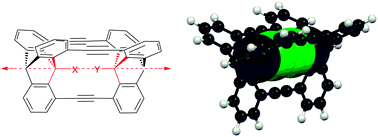Close covalent contacts: gauging molecular compression in a molecular compression chamber
Abstract
A computational investigation is carried out on a 3-fold symmetric model molecular compression chamber comprising two triply-bridged triptycenes with variable endo-pointing substituents. Assessment of the strain of the constant scaffold serves to gauge the compression stress across variable interaction partners at unusually short C–X distance, and creates a transferable knowledge base for the design of molecules with close contacts due to bond length compression. Results motivate ideas in the design of more effective molecular compression chambers and their realization through chemical synthesis.


 Please wait while we load your content...
Please wait while we load your content...